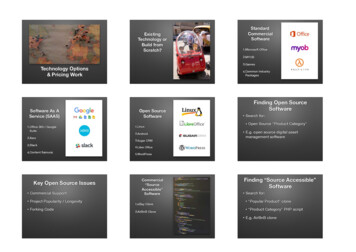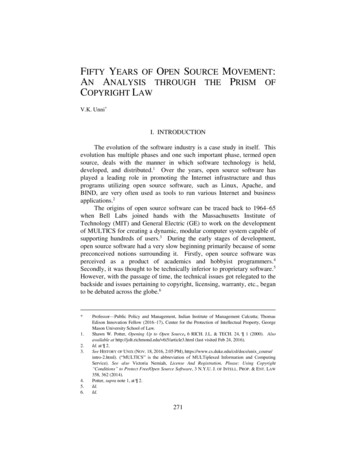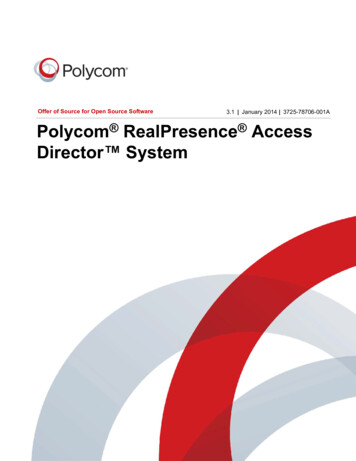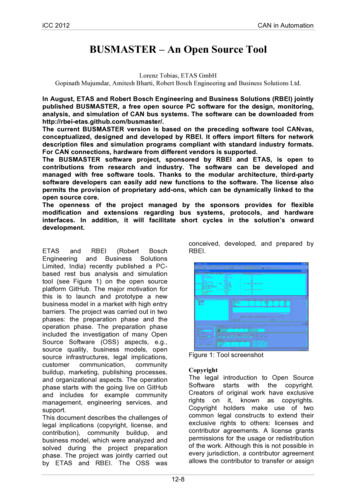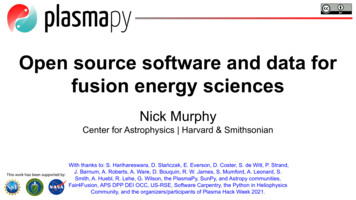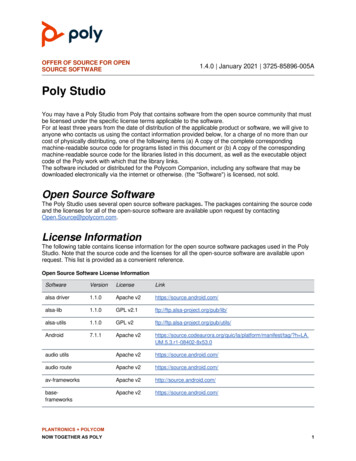
Transcription
School of ManagementBlekinge Institute of TechnologyOpen Source Strategy – The Case of NokiaAuthor:Shamayel KhanSupervisor:Anders HederstiernaThesis for the Master’s degree in Business Administration 2009
Title: Open Source Strategy – The Case of NokiaAuthor: Shamayel KhanSupervisor: Anders HederstiernaDepartment: School of Management, Blekinge Institute of TechnologyCourse: Master’s thesis in business administration, 15 credits (ECTS).Background Discussion: Nokia’s announcement in 2008 to put its Symbian based OperatingSystems in the Open Source domain came in the face of expected competition from other OpenSource Software (OSS) rivals such as Google’s Android OS. Moreover, Nokia now relies solely onOSS in order to power the higher end range of its products.Purpose: The purpose of this thesis is to present a snapshot picture of the current mobile devicesmarket in general and where Nokia stands in particular when it comes to employing Open SourceSoftware in the mobile devices market.Method: The study will be a combination of both academic and empirical research.Academic research will be relied upon when talking generally about future trends and strategieswhich the company is expected to develop and follow.Empirical study will be used when comparing already available data with regards to other OSS andhow they have performed in the past. Conclusions with regards to their success and effectivenesscan be drawn by observing their performance in the software market and how they compared withtheir closed source rivals. These conclusions will be used to underline the decisions taken by Nokiawith regards to OSS.Theory: Later parts of the thesis rely upon press statements, public deals, business analysis andpredictions made by industry insiders to deduce some conclusions with regards to Nokia’s OSSstrategy in the mobile devices market.Analysis: Relying on available data and future trends and analysis, a theoretical picture of Nokia’sstrategy of employing OSS in its high end phone products is presented. Reasons and triggers fordoing so are presented and predictions are made with regards to chances of future success ofemploying such a strategy.Conclusion: The results of both the empirical and theoretical parts of the thesis showed thatNokia’s present OSS strategy makes sense when looked at from the current market perspective andthe competition the company faces. However it cannot be concluded that OSS is a silver bulletwhich would solve all the company’s issues. Without innovative products and services the future ofNokia might see a gradual decline despite Open Sourcing its staple software. The ideal combinationwhich would seem to be most effective is a combination of both OSS combined with the company’sability to leverage that software into more innovative products which offer the consumerssomething useful and different.
SummaryThe commercial mobile phone industry is a relatively new one. Starting out in the 1980s, it hasproliferated in both numbers and in terms of technology. The last decade saw a sharp increase inboth the number of subscribers and the amount of services which was offered by mobile devices. Inorder to keep up with this fast evolution of the industry, phones have started to get much morecomplicated and ‘smarter’ due to the software which is used to run these phones. Multi touch screenmenus, High Definition video playback, multi megapixel cameras and a plethora of connectivityoptions are just some of the features a consumer takes for granted in his/her new mobile device.In order to provide these services to the user the software inside the phone has gotten complex tothe scale of becoming its own Operating System much akin to the Operating Systems used onpersonal computers. These mobile operating systems contain millions of lines of software code andcost a lot of money to maintain and develop. Moreover having a popular operating system benefitsthe organization as it draws in many developers who can write applications which run on thisoperating system and also develop services which are specific to the operating systems. Havingthese services generate revenue for the network operators who get to bill the consumers for usingthe services or for the data which has been transferred to and from these mobile phones via theoperator’s network.Nokia’s dominant market share in the smartphone market entails that it holds a near 40% share withits smartphone operating systems. Gradually the company has been moving towards opening up itspreviously proprietary operating systems to the public in the form of Open Source Software, whereeveryone is able to view, share, distribute and contribute to the software code. This strategy changehas been taking place over the last couple of years and continues under an overall change ofdirection and focus which is taking place in the company.This thesis work relates as to what exactly is the current placement of Nokia in the economic andmobile devices market and how the company has been adapting to the challenges it has been facingat the hands of both old and new rivals who have been coming with innovative ideas in order totopple over Nokia from its throne of being the biggest mobile phone maker in the world. The thesisfirst looks at exactly what is Open Source Software. From there it gradually moves to docomparisons between closed and Open Source Software in order to give the reader an idea as towhat are the pros and cons of each.In the second half of the thesis a snapshot of the current market situation and competitors is given inorder to understand the environment in which Nokia has been working and developing its strategyin. Later on the thesis goes in depth about the decisions, their triggers and their implications withregards to Nokia and the use of Open Source Software as a strategy in this changing environment.Keywords: Nokia, Open Source Software, strategy, mobile phones, mobile operating systems,software, smartphone, internet tablet, OSS,
AcknowledgementsI would like to acknowledge the Blekinge Institute of Technology in general and the School ofManagement in particular for making available the Masters in Business Administration program tostudents from all over the world. I would also like to thank the Swedish government for making thisdistance learning program freely available to everyone.I would like to acknowledge the patience of my wife and my son for bearing with me as I workedon my thesis and probably neglected some of my fatherly duties.Also would like to thank my parents for instilling in me the value that hard work always pays off.I would also like to acknowledge the time and effort put into this thesis by my supervisor AndersHederstierna and his guidance which gave focus to this thesis. Furthermore I would also like toacknowledge our overall MBA thesis program coordinator Klaus Solberg Søilen for arranging andmanaging this course in a professional manner.
Table of ContentsOpen Source Strategy – The Case of Nokia . 11CHAPTER ONE: Introduction . 91.1Background. 91.2The Thesis . 101.2.11.2.21.2.31.2.42Motivation for this thesis . 10Objectives of the thesis and Hypotheses . 10Methodology . 11Outline of the thesis . 12CHAPTER TWO: Open Source Software. 132.1Fundamentals of Open Source Software. 132.2History of Open Source Software . 142.3Relevant Open Source Software Licenses . 152.3.12.3.22.3.3The General Public License or GPL . 15The Eclipse Public License or EPL. 16The Apache License or AL (formerly The Apache Software License or ASL) . 172.4Development Methods in OSS Communities . 172.5The Economics of Open Source Software . 192.5.12.5.22.6Business reasons for organizations . 19Business reasons for programmers . 21Open Source Software and Innovation . 222.6.12.6.23The Open Innovation concept . 22Open Innovation concept and OSS . 23CHAPTER THREE: Open Source Software vs. Closed Source Software . 243.1Comparison aspects . .103.1.113.24System Growth . 25Innovation and Creativity . 25Number of Defects . 26Simplicity . 27Modularity . 27Overhead . 28Testing . 29Overall Strategy . 29Marketing . 29Visibility and collaboration . 30Economic motivations . 30Conclusion. 31CHAPTER FOUR: Nokia and the evolving mobile devices market . 324.14.1.14.1.24.1.34.1.44.1.54.1.6Current Mobile Operating Systems . 33Symbian OS . 33Windows Mobile. 34RIM BlackBerry OS . 35Android OS . 36iPhone OS (Mac OSX). 37Maemo OS . 384.2Current Mobile Phone Market and Market Shares . 394.3Innovation seems to be the key . 42
4.45CHAPTER FIVE: Nokia’s OSS Strategy . 465.15.1.15.1.2Current direction of the company . 47Recent news about OSS Software in Nokia . 47Recent acquisitions, divestments and agreements related to OSS . 495.2Triggers for going Open Source. 505.3Choice of OSS Licenses. re outlook on the smartphone market . 43Maemo OS . 52Symbian OS . 52Conclusion . 53Nokia objectives with its OSS strategy . 54Innovation Diffusion . 54Quality . 55Creating an ecosystem . 55Market dominance . 56Competitiveness . 565.5Conclusion. 575.6Previous Studies and Summary . 57CHAPTER SIX: Future OSS strategy and conclusions. 596.1Future development and OSS strategy. 596.2Maemo OS strategy . 606.3Symbian OS strategy. 606.4Future OS strategy . 616.5Risk Aversion with Multiple Platforms. 616.6Conclusions . 616.7Final Words . 68
List of FiguresFigure 4-1: S60 OS screenshot (Image source: AllaboutSymbian) . 34Figure 4-2: Windows Mobile OS screenshot (Image source: MSDN blogs) . 35Figure 4-3: Blackberry OS screenshot (Image source: Blackberry) . 36Figure 4-4: Android OS screenshot (Image source:Intomobile) . 37Figure 4-5: iPhone OS screenshot (Image source: Gadgettrak) . 38Figure 4-6: Maemo 5 OS screenshot (Image source: MobileReview) . 39
List of ChartsChart 4-1: Mobile Phone Unit Sales to End Customers . 40Chart 4-2: Smartphone Sales by Operating System in 2008-09 . 41
1 CHAPTER ONE: Introduction1.1 BackgroundNokia is a Finnish technology company that is currently the biggest manufacturer and supplier ofmobile phones in the world and has been holding that position since many years.Nokia’s device and mobile phone portfolio consists of a number of line-ups each distinguished bythe capability of the devices and the software which is run on those devices. The software comes inthe form of different platforms or Operating Systems (OS). A platform is an operating system whichis modular and can be configured quickly to conform to the features which are present on thedifferent phones. Thus a platform is the basic building block of the product software which is run onthe device and the end user sees on the screen of their mobile phone in the form of different menusand graphics.Nokia’s basic level device line-up consists of cheap low-end phones which use the company’sproprietary S40 operating system. These phones form the bulk of sales for the company particularlyin the emerging markets of the developing world. The S40 OS is not considered to be a smartphoneOS and it does not offer multitasking and the data processing capabilities of the company’s otherplatform offerings.Apart from the S40, Nokia uses the S60 OS and a Linux based platform known as ‘Maemo’. TheS60 OS is based on the Symbian OS which was developed by Symbian Ltd. for usage insmartphones in the late 1990s. Both the S60 and the Maemo platforms are considered to besmartphone Operating Systems and are used in the company’s higher end phones and internetdevices. The S60 OS is more geared towards usage in high end smartphones and is currently themost widely used smartphone OS in the world (Gartner, 2009).The S60 OS started out as a proprietary software and it still is, however work is underway to openup it’s source code over the next two years to make it an Open Sourced Software (OSS) as part ofNokia’s future strategy to adopt more open sourced software in it’s mobile phones and devices andfocus more on device configuration and services.The Maemo OS, on the other hand, is being used in devices known as ‘internet tablets’ which donot usually offer cellular (the ability to make calls and use other services provided by mobile phoneoperators/networks) services. These devices are used in areas covered by wireless internet accesspoints in order to offer a device with the ability to access the internet. However recently Nokiaannounced its N900 internet tablet which; for the first time, offers cellular call capabilities (NokiaN900, 2009).The Maemo OS started out as an OSS due to the fact that it is based on Linux, which is probablythe most famous OSS in the world.From the point of view of this thesis, the focus will be on the Nokia’s strategy which relates to thechanges taking place in the S60 OS with the plans of opening up its source code to members of afoundation and to the general public under the Eclipse Public License (EPL) over the next two yearsand with regards to the Maemo OS.
1.2 The Thesis1.2.1 Motivation for this thesisThe announcement, in 2008, by mobile phone giant Nokia, regarding the creation of an opensource community and the distribution of the previously proprietary smartphone operatingsystem, S60, was a major change in the way of Nokia’s business model. Previously Nokia hadkept the source code of the world’s most popular smartphone OS under wraps. However withchanging market scenarios and major new competitors, such as Google’s Android OS, whichthreaten to encroach on Nokia’s share of the smartphone OS market, the company has decided togo the way of Open Source Software (OSS) by making the source code of its OS availablethrough a community of members known as the Symbian Foundation. The plan is to graduallymake the software public over the next two years.In addition to this Nokia’s continuing investment in the Linux based Maemo platform whichpowers Nokia’s internet tablet devices also correlates to the open sourced software trend whichseems to be shaping up the company in particular and the future of the mobile phones market ingeneral.1.2.2 Objectives of the thesis and HypothesesThis thesis work will be an overall analysis of the current situation that Nokia finds itself in froman OSS perspective. It will aim to create a picture of the current as well as the developingscenarios which Nokia is expected to face in the upcoming years.This thesis will also try to understand some of the reasons behind Nokia’s change in strategy fromusing proprietary software, such as the S40 and the S60 OSs, to employing OSS and practices inits handsets and other related services. The probable reasons, changing market environment andrisks will be explained so as to understand the basis of the change which in turn will clarify thefull picture of future growth and path which the handset market will possibly take. Moreover theeffects of open sourced software on spurring development of new applications and services willbe examined. Similar software models in related industries, such as personal computing, can beused as a reference as to how OSS can remain competitive in the face of closed source orproprietary software. These findings can also be used to extrapolate the future growth andinnovation prospects for Nokia’s new OSS strategy.The following null hypotheses are identified:1. Not moving away from proprietary software and not employing OSS will reducedevelopment cost and time and make the software more competitive.2. Nokia needs to base its devices on proprietary software in order to counter competitionfrom Google’s Android OS and prevent it from eating into its market share.3. Keeping the Symbian OS platform proprietary and using a closed source eco-system for itsdevelopment will make it more attractive to the developer community and other handsetmakers.
4. Investing in a single and closed source OS like Symbian OS will help in building on theinvestment which has already taken place in the previously closed source S60 OS.5. Closed sourced software is better suited for incorporating more technologically cuttingedge applications and spur innovation.1.2.3 MethodologyDifferent methodologies will be applied in the course of this thesis. The study will be a mixture ofboth academic and empirical research.Academic research will be relied upon when talking generally about future trends and strategieswhich the company is expected to develop and follow. As it is impossible to get data regarding whatresults future actions and strategies of the company will formulate, a purely theoretical study will beused in order to support or disprove the hypotheses which pertain to the future context.Empirical study will be used when comparing already available data with regards to other OSS andhow they have performed in the past. Conclusions with regards to their success and effectivenesscan be drawn by observing their performance in the software market and how they compared withtheir closed source rivals.The following methodologies will be employed when trying to explain the research queries:- A study and comparisons of different open sourced models which are available in the current ITindustry can be used as a role model or a reference. For example two software where one uses anopen sourced approach while the other a closed source can be compared to draw someconclusions regarding the differences between open sourced and closed source software.This will be used as secondary empirical research.- Employing Nokia’s non-confidential strategy related statements, press releases and pressstatements from Nokia’s management as a sort of ‘window’ to how the management thinks andhow the strategy inside the company is being shaped.This will be used as secondary academic study and will apply mostly to the parts explaining thedirection in which the company is headed currently as well as where it will be in the future.- Findings and theories from different articles and research papers regarding the benefits of usingOSS and methodology in today’s IT companies can be utilized. These will then be correlated withNokia’s overall strategy.These are both secondary academic as well as empirical.
1.2.4 Outline of the thesisThe thesis is sub-divided into 6 chapters.- Chapter one provides the introduction to the whole thesis as well as information regardingthe company (Nokia) which is being taken as the subject of this thesis. Moreover themotivation for the thesis, the hypotheses generated and the methodologies which will beused to discuss the hypotheses are mentioned.-Chapter two deals with the definition of Open Source Software and its many differentlicensing mechanisms. The focus on the licensing part is important to understand whereNokia (and its rivals) are headed judging by the licenses under which they are releasing orplanning to release their Open Source products.-Chapter three is a comparison between the OSS and the closed source development process.The benefits and pitfalls of each and how successful OSS projects have been run andcompare with their contemporaries from the closed source world. This chapter will set thebase upon which a number of the offered hypotheses can be debated in later chapters.-Chapter four jumps right into where Nokia is positioned with respect to the currentenvironment prevalent in the mobile phone market. There is a primer on Nokia’s rivals andthe current market environment. We also analyze what the management has said openly withregards to the future of the company’s software and devices. In this chapter we also try toanalyze different management decisions which might indicate the general course of actionand the shape which the company might take in the future.-Chapter five brings together the data from chapter three and four and analyzes the perceivedcourse of action from Nokia and how it might affect the future picture of the industry ingeneral and Nokia in particular. Whether the direction into which Nokia is evolving(discussed in chapter four) fits well with the empirical evidence (from chapter three) in orderto put Nokia in an advantageous position when seen from the industry’s point of view.-Chapter six deals with the future OSS strategy which Nokia might follow. Predictions andassumptions abound in this chapter where a perceived course of action by the company isdebated. Conclusion, discussion on the hypothesis and rejection/not-rejection of the nullhypotheses plus any closing remarks of the thesis are also mentioned in this chapter.
2 CHAPTER TWO: Open Source SoftwareRecently Open Source Software (OSS) has been witnessing a growing market share and a growingpopularity as compared to the traditional commercial methods of software development (Henley &Kemp, 2008). The future for this method of software development and distribution seems bright asnew methods of delivering and licensing the software virtualization and remote services aredeveloped.2.1 Fundamentals of Open Source SoftwareThe basic idea of Open Source Software or OSS is the ready availability of the source code of thesoftware application. This generally also includes the permission to modify and improve the sourcecode. The originator usually does not give up the ownership of the software in an OSS. Intraditional commercial methods of software development, the software application is a proprietaryproduct whose source code is kept under wraps and under intellectual copyrights of the companywhich wrote the source code.The source code is the actual human readable lines of instructions of a computer application whichconsist of the instruction set which the program follows.Software is generally distributed as an executable which is in the form of binary instructions
School of Management Blekinge Institute of Technology Open Source Strategy - The Case of Nokia Author: Shamayel Khan Supervisor: Anders Hederstierna




